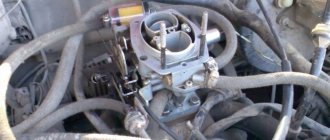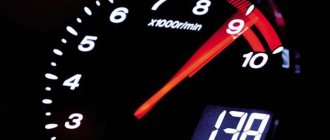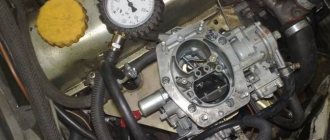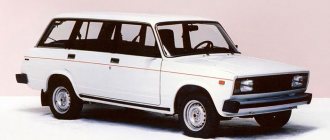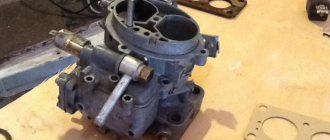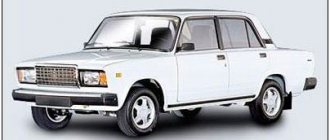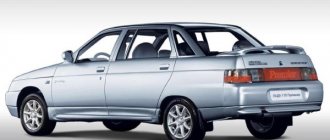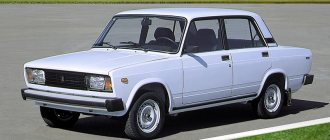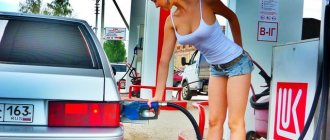In the second half of the 80s. last century, fuel consumption on the VAZ-2109 met international requirements for efficiency. The plant offered several modifications of carburetor engines, differing in displacement, power and fuel consumption. Later, options appeared with gasoline injection systems, which made it possible to reduce the toxicity of exhaust gases.
The fuel consumption of the VAZ-2109 meets the requirements for efficiency.
Description and technical characteristics of the VAZ-2109 car
Cars with a 5-door hatchback body began to be produced in 1987.
... about the model parameters
Initially, the plant offered versions with 1.3 and 1.5 liter carburetor engines for the domestic market, and a model with a 1.1 liter engine was assembled for export.
In the early 90s, the body and interior were modernized, and already in 1995 the first commercial samples appeared with a 1.5 liter gasoline unit with a GM injection system. Car production continued until 2011 (in Ukraine), and the equipment was equipped with an 8-valve VAZ-11183 engine with a displacement increased to 1.6 liters.
The vehicles were equipped with a manual transmission with 4 or 5 forward gears and a cylindrical main pair. Torque was transmitted to the front wheels with MacPherson struts and coil springs.
A torsion beam with shock absorbers and drum brakes was used at the rear (discs at the front). Panels molded from plastic were widely used in interior decoration. The vehicle is equipped with rack and pinion steering (no power assist).
Brief technical characteristics of the VAZ-2109:
- body length - 4006 mm;
- width without mirrors - 1650 mm;
- height (on standard tires 165/70R13) - 1402 mm;
- ground clearance - 165 mm;
- wheelbase - 2460 mm;
- curb weight - 945 kg;
- load capacity - 425 kg.
The VAZ-2109 was equipped with a manual gearbox.
Setting the ignition timing
When the ignition timing is correctly set, all indicators of engine performance (reactivity, power, idling, energy consumption) are within normal limits. To carry out the work, you must have a strobe and a tachometer, an open-end or socket wrench of 10. In general terms, the setup is done as follows:
- The engine warms up to operating temperature. Low idle speeds are set by ear or on the tachometer (less than 800 rpm), after which the engine is turned off.
- On the gearbox housing, look for a hatch with a visible part of the flywheel and a scale. Most often it is closed with a rubber stopper that needs to be removed.
Actual fuel consumption depending on engine type
In addition to cars with a standard body, in 1995-99. A Baltic modification was assembled in Finland, which differed in the design of the interior, front and rear. All assembled hatchbacks were equipped with a 1.5-liter VAZ-2111 engine. Fuel consumption did not differ from that of its Russian counterparts. The table shows the engine models and the efficiency characteristics declared by the AvtoVAZ plant (in liters per 100 km).
Fuel consumption of VAZ-2109 by engine model brand
Most of the hatchbacks built were used by the Ministry of Internal Affairs. Cars are periodically found on the secondary market.
Solex carburetor. How to reduce consumption by selecting jets
Fuel consumption on Lada Vesta
This is a fairly simple and effective way to increase the efficiency of a gasoline engine. The essence of the method is to select fuel jets for the main dosing system. The jet is selected only for the first chamber and the idle system is adjusted.
- The engine warms up to operating temperature (about 90 degrees).
- A bottle of gasoline is installed under the hood. The suction fitting of the fuel pump is disconnected from the fuel hose and connected to the bottle with another hose.
- A control section is driven through at an optimal speed of 60-70 km/h and the fuel level in the bottle is measured.
- The carburetor cover is removed, the jet is changed to another, smaller cross-section (for example, 107.5 to 105). After this, the used fuel is measured again at the control section. At the same time, the dynamics of the car and the appearance of dips when pressing the accelerator are carefully monitored.
- In a normal situation, you can change the jet to an even smaller one. When failures occur, the experiments are stopped. After this, the idle speed is adjusted.
- The idle fuel jet is changed to a similar one, but with a larger cross-section (for example, 40 to 42), the speed is adjusted, and a test run is performed.
- If, as a result of the adjustment, the dips disappear, the adjustment was successful; if not, the idle jet is changed to an increased one and the race is carried out again.
The result of all these manipulations should be stable operation of the engine at idle, no dip in the gas pedal when starting and driving. The main result is a reduction in fuel costs.
Real fuel consumption per 100 kilometers
During the operation of the equipment, drivers note a deviation in fuel consumption in a larger direction compared to the factory data. When carrying out certification, the manufacturer takes measurements at the test site, creating the most comfortable conditions.
... about factory fuel consumption measurements
The cars are driven by experienced testers, who are tasked with achieving minimal gasoline consumption while simulating various operating conditions.
Injector
The use of a distributed injection system made it possible to smoothly regulate the composition of the fuel-air mixture depending on the load and temperature of the cooling system. As a result, exhaust toxicity dropped, but gasoline consumption remained the same. A 1.5 liter engine burns up to 10 liters of fuel in urban conditions, and on the highway the car needs 6.5-7 liters of fuel at speeds of up to 110 km/h. The modification with a 1.6-liter unit is characterized by increased gasoline costs in populated areas (up to 11 liters in winter or in heavy traffic jams).
The injector allows you to regulate the composition of the fuel-air mixture.
Carburetor
On carburetor cars with a rare 1.1-liter engine, consumption in urban conditions does not exceed 9 liters, on the highway you can keep within 6 liters. The common 1.3-liter version shows similar results in populated areas, and on the highway at 90 km/h and a calm driving pace, the engine requires about 5.5 liters of A-95 gasoline.
... about fuel consumption
A modification with a volume of 1.5 liters consumes up to 10 liters in the city. On the highway at 100-110 km/h the car burns no more than 7 liters of fuel.
Owner reviews
“An excellent car, especially for Russian roads. In appearance, the car seems small, but inside there is a lot of space for both passengers and various cargo. I use the car mainly for work: during the day I deliver goods to stores, and in the evenings I work part-time as a taxi driver. The car performs well in both directions. The interior is quite comfortable, the seating is comfortable, but the equipment is rather weak even on a model released in the 21st century. Everything is assembled with high quality, reliably, for many years to come, but there is practically no sound insulation. On the one hand, this is a plus, since you can enjoy the sound of the engine when driving along the highway, but it quickly gets boring. I plan to solve this problem soon. In the city there are no particular problems in using it, since the car has good handling, and the whole suspension as a whole. But I was unlucky with one. My car has high consumption, although others do not have such problems. I spend about 10 liters,” writes Valery from Ufa.
“This is my first car after getting my license. I don’t really like it in stock, but I plan to make it for myself. I'll paint it and make body kits. The salon is still more or less here, but I’ll also create something. I’ll re-sew it into leather, the tidy into Alcantara, and I’ll assemble everything better. Since I plan to drive fast, I will also do some work on the engine. Stock is very weak for its volume. But the gas mileage is very decent, even on par with foreign cars. I have never had to spend more than 9 liters in the city, although I drive often and quickly,” Alexander from Voronezh left this review about the car.
“My father gave me this car. He bought a foreign car for himself, saying that I should gain experience in driving a domestic car. Once you learn how to drive it, you can drive anything. At first, the controls seemed very difficult to me, since there was nothing at all that would make driving easier. But then I got used to it, and even began to like it. The car is very decent, well suited for the city. There is a lot of space inside, it is comfortable to sit. The only bad thing is that over time this engine has become too weak for me, because I want to go on the track and enjoy the speed. But it has a low consumption, which is only 8 liters,” wrote Maxim from Kaliningrad.
“Many friends advised me to take a nine, but not a simple one, but with a larger engine, since it is much better in everything. But somehow I didn’t particularly like her. I was hoping for something more comfortable and technologically advanced. The car was produced in 2000, and it is equipped with technologies from the eighties. The engine is frankly weak, it barely pulls for its volume. I am glad that at least it consumes little fuel, no more than 9 liters. Perhaps, if various modifications are made, the car will give a pleasant driving experience, but so far this is not happening,” this is a review from Leonid from Lipetsk.
“I bought an improved nine secondhand, because I had long wanted to take it, but as a second car. I plan to carry out a number of various improvements with it and travel to exhibitions, since such cars are very popular. I want to leave only the body from stock, and I’ll wrap that as best I can so that only the outlines are recognizable. For now I drive stock, because I need to earn money for all this. The car itself is not bad, but I couldn’t drive it all the time. The level of comfort is minimal, and the engine is not up to par with foreign competitors. But there is a pleasant bonus - fuel consumption does not exceed 9 liters,” wrote Dmitry from Krasnodar.
“Over the years I have driven many of our cars, but I decided to stop at the VAZ 21093. I always liked the Nine, and here is also a version with a large engine, which shows quite tolerable speed and acceleration. In terms of comfort, the car is no better than previous models and is clearly one step lower than foreign cars, but the sensations and adrenaline from driving cannot be expressed in words. I don’t plan to change the car for another one, since I simply can’t find such an indicator of consumption in the city for this price. My average is 8 liters,” this is a review from Pavel from Yekaterinburg.
Source
Reasons for increased fuel consumption of VAZ-2109
Owners of VAZ-2109 cars may experience a sudden increase in fuel consumption resulting from breakdown or improper adjustment of power unit components. It should be noted that in winter and in heavy traffic jams, gasoline costs may temporarily increase by 10-15%, which is not a sign of a malfunction. The systems must be checked at a steadily increasing flow rate, regardless of the driving mode and interior load.
The car is not working properly
Engine efficiency is negatively affected by improper adjustment of the ignition system (including malfunctions of the ignition coil, early or late ignition) and carburetor (the problem does not apply to engines with an injector equipped with an electronic control unit). Incorrectly configured wheel bearings or poorly aligned front wheel alignment angles contribute to deterioration in handling and lead to an increase in consumption by 1-2 liters.
Engine efficiency is affected by adjusting the ignition system.
... about fuel consumption
An additional negative impact is caused by worn piston parts or a jammed cooling system thermostat.
Driving style
Fuel costs also depend on driving style and operating conditions. Drivers who rev the engine to maximum speed and drive in low gears receive city consumption of 11-11.5 liters. On the highway, when accelerating to 120-130 km/h, the engine burns 8-9 liters of fuel. If the car is operated with a trailer or roof rack, then the engine will require additional fuel (from 1 to 2 liters depending on the mode of travel).
Malfunction of valves or dampers
On carburetor engines, fuel consumption is affected by the correct throttle valve adjustment and the serviceability of the solenoid valves. An incorrectly configured fuel mixture supply system worsens dynamics, makes it difficult to start the engine and increases gasoline costs by 5-10%. Owners are recommended to periodically check the correct operation of the carburetor and adjust the main components.
Malfunction of the valves increases fuel consumption.
Problems with EPHH
By default, engine carburetors on the VAZ-2109 were equipped with a forced idle economizer (EFI), which made it possible to reduce fuel consumption and reduce exhaust toxicity. The system included a solenoid valve, which operated based on a signal from the controller and a switch located on the throttle valve drive axis. If the EPH components malfunction, fuel consumption increases.
Failures in the control system
On cars with a distributed injection system, fuel consumption increases when the sensors break down or the wiring harnesses are damaged. The driver receives a signal about any malfunctions via the Check Engine warning lamp installed in the instrument cluster. To determine the faulty unit, a diagnostic computer is used, which is connected to a special connector.
Reduced fuel pressure and injector failure
On injection power systems, fuel is supplied by an electric fuel pump. The pressure regulator located in the ramp dumps excess gasoline back into the tank. If a pump or valve breaks down, the normal operation of the engine is disrupted, which leads to an increase in fuel consumption. Efficiency is affected by the condition of the spray heads of the fuel injectors, which gradually become clogged with dirt and require cleaning in an ultrasonic bath.
...about fuel consumption diagnostics
Faulty electromagnetic injectors are detected during computer diagnostics.
Overconsumption when equipped with an injector
It is worth noting that when changing the fuel supply system, the excess use of gasoline is not less, but has a number of other reasons. Therefore, the fuel consumption of the VAZ 2109 injector corresponds to these indicators
:
- fuel consumption in the city is 7-8 liters per 100 km
- Gasoline consumption standards for the Lada 2109 on the highway are 5-6 liters per 100 km, at a speed of 90 km/h
- fuel consumption on the highway at a speed of 120 km/h - 8-9 liters per 100 km
Failure in the VAZ control system
Any interruptions in the electronic equipment of the car lead to the fact that the real fuel consumption on the injection VAZ 2109 is growing rapidly. If the temperature, oxygen, or mass air flow sensors do not work correctly, the electronic control unit cannot adequately respond to changes. This provokes a sharp deterioration in the fuel situation.
Reduced pressure and injector failure in a VAZ
A decrease in pressure in the fuel system leads to an immediate decrease in the power of a VAZ vehicle, which increases the period of engine operation at high speeds. Damage to the injector itself immediately increases fuel consumption. To avoid this, you need to periodically clean the injectors.
Source
Effective methods for reducing fuel consumption of VAZ-2109
To reduce fuel costs you need to:
- maintain the good condition of the power unit;
- control the operation of brake mechanisms and wheel bearings;
- do not install additional elements on the body that increase resistance;
- check and adjust tire pressure;
- do not travel at speeds exceeding 100 km/h and avoid driving with the windows open;
- refrain from traveling short distances at sub-zero temperatures;
- Avoid overloading the vehicle and avoiding prolonged driving in low gears.

